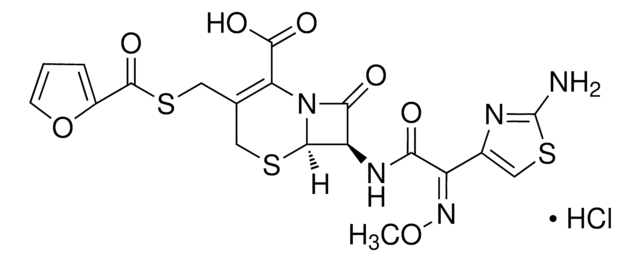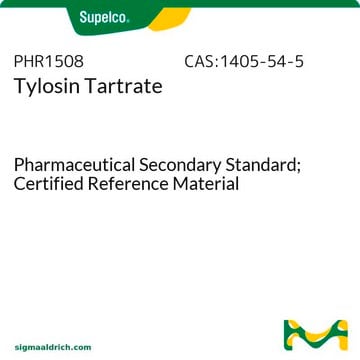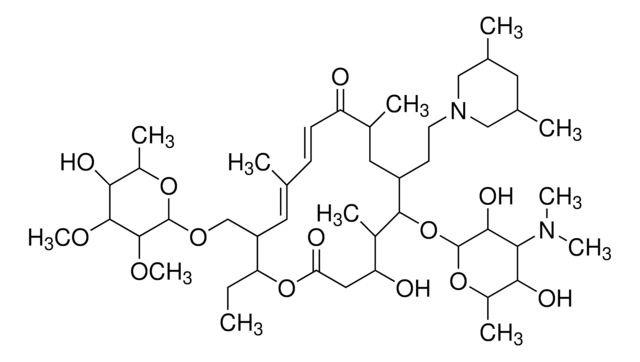F1427
Florfenicol
analytical standard, for drug analysis
동의어(들):
Aquafen, Nuflor, SCH-25298, [R-(R*,S*)]-2,2-Dichloro-N-[1-(fluoromethyl)-2-hydroxy-2-[4-(methylsulfonyl)phenyl]ethyl]acetamide
About This Item
추천 제품
Grade
analytical standard, for drug analysis
Quality Level
형태
solid
기술
HPLC: suitable
gas chromatography (GC): suitable
응용 분야
forensics and toxicology
pharmaceutical (small molecule)
veterinary
형식
neat
SMILES string
CS(=O)(=O)c1ccc(cc1)[C@@H](O)[C@@H](CF)NC(=O)C(Cl)Cl
InChI
1S/C12H14Cl2FNO4S/c1-21(19,20)8-4-2-7(3-5-8)10(17)9(6-15)16-12(18)11(13)14/h2-5,9-11,17H,6H2,1H3,(H,16,18)/t9-,10-/m1/s1
InChI key
AYIRNRDRBQJXIF-NXEZZACHSA-N
유사한 제품을 찾으십니까? 방문 제품 비교 안내
일반 설명
애플리케이션
- To measure florfenicol and its main metabolite florfenicol amine in tilapia meat by solid phase extraction (SPE) and ultra high-performance liquid chromatography-tandem mass spectrometry (UHPLC-MS/MS)
- Multi-residue analysis of three amfenicols in animal feed samples by HPLC-MS/MS method, following European Commission Decision 2002/657/EC(2)Determination of florfenicol in different animal feedstuff samples by thin layer chromatography (TLC) coupled with HPLC-UV detection
- Residue analysis of florfenicol in broiler meat and liver samples by a reversed phase-HPLC method in combination with UV detection at 223 nm
- Competitive indirect-chemiluminescent enzyme-linked immunosorbent assay (CL-ELISA) based quantitative analysis of florfenicol and its major metabolite florfenicol amine in chicken muscle samples, validated as per Commission Decision 2002/657/EC
기타 정보
신호어
Danger
유해 및 위험 성명서
Hazard Classifications
Aquatic Acute 1 - Aquatic Chronic 1 - Repr. 2 - STOT RE 1
표적 기관
Liver,Brain,Testes,Spinal cord,Blood,gallbladder
Storage Class Code
6.1C - Combustible acute toxic Cat.3 / toxic compounds or compounds which causing chronic effects
WGK
WGK 3
Flash Point (°F)
Not applicable
Flash Point (°C)
Not applicable
개인 보호 장비
Eyeshields, Gloves, type N95 (US)
Choose from one of the most recent versions:
이미 열람한 고객
자사의 과학자팀은 생명 과학, 재료 과학, 화학 합성, 크로마토그래피, 분석 및 기타 많은 영역을 포함한 모든 과학 분야에 경험이 있습니다..
고객지원팀으로 연락바랍니다.

















